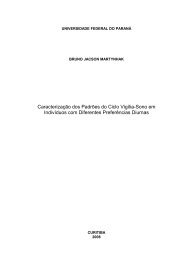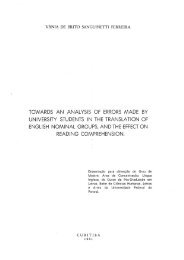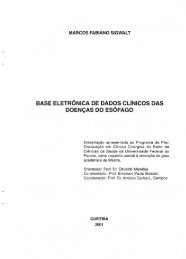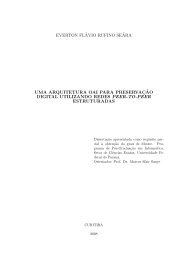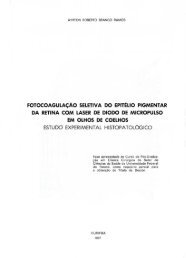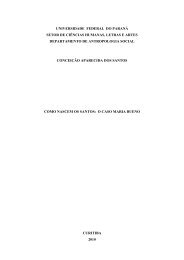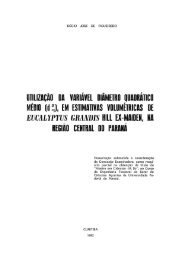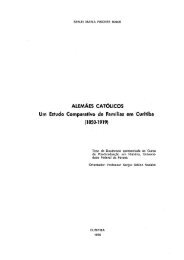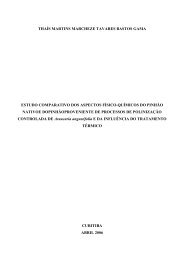identificação e manejo de nematóides da bananeira - Universidade ...
identificação e manejo de nematóides da bananeira - Universidade ...
identificação e manejo de nematóides da bananeira - Universidade ...
You also want an ePaper? Increase the reach of your titles
YUMPU automatically turns print PDFs into web optimized ePapers that Google loves.
TABELA – 5 FREQÜÊNCIA ABSOLUTA E DENSIDADES POPULACIONAIS MÉDIA E<br />
MÁXIMA DOS NEMATÓIDES EM AMOSTRAS DE RAÍZES E SOLO DE<br />
BANANEIRAS, SEGUNDO OS MUNICÍPIOS NO LESTEL DO PARANÁ -<br />
2005/2006<br />
Conclusão<br />
(1) Em 10 g <strong>de</strong> raiz e 100 cm 3 Raiz Solo Raiz Solo Raiz Solo<br />
São José dos Pinhais Radopholus 38 38 155 21 996 68<br />
Meloidogyne 88 75 131 276 400 624<br />
Helicotylenchus 100 75 437 393 960 1 484<br />
Tylenchus 38 63 4 25 24 112<br />
Aphelenchus 25 38 1,5 2 8 8<br />
Trichodorus 0 25 0 4 0 24<br />
Mesocriconema 0 38 0 7 0 32<br />
NPP2<br />
<strong>de</strong> solo.<br />
(2) Nematói<strong>de</strong>s não parasitos <strong>de</strong> plantas.<br />
100 75 43 86 60 246<br />
Meloidogyne foi o segundo gênero mais freqüente nas amostras <strong>de</strong> raízes,<br />
concor<strong>da</strong>ndo com resultados <strong>de</strong> outros levantamentos realizados no Brasil (ZEM,<br />
1982b; MAIA e LOBATO, 1994; SOUZA, MAXIMINIANO e CAMPOS, 1999;<br />
RITZINGER, 2003; e PEREIRA et al., 2006) (Tabela 2). Nas amostras <strong>de</strong> solo o<br />
nematói<strong>de</strong> <strong>da</strong>s galhas apresentou a segun<strong>da</strong> maior <strong>de</strong>nsi<strong>da</strong><strong>de</strong> média e máxima,<br />
provavelmente influencia<strong>da</strong>s pela biologia do nematói<strong>de</strong> e pela ampla gama <strong>de</strong><br />
hospe<strong>de</strong>iros, incluindo espécies <strong>de</strong> plantas <strong>da</strong>ninhas presentes nos bananais (ZEM,<br />
1982b).<br />
MUNICÍPIO<br />
NEMATÓIDE<br />
FREQÜÊNCIA<br />
(%)<br />
Embora tenha sido apenas o terceiro mais freqüente nas amostras <strong>de</strong> solo e<br />
raízes, o nematói<strong>de</strong> cavernícola apresentou a maior <strong>de</strong>nsi<strong>da</strong><strong>de</strong> média e máxima entre<br />
todos os nematói<strong>de</strong>s (Tabela 5). Em amostra <strong>de</strong> Guaratuba, a <strong>de</strong>nsi<strong>da</strong><strong>de</strong> populacional<br />
<strong>de</strong> R. similis alcançou 13.900 nematói<strong>de</strong>s/10 g <strong>de</strong> raízes (Apêndice V). O ciclo mais<br />
curto <strong>de</strong> R. similis, quando comparado com Helicotylenchus spp., o modo <strong>de</strong> vi<strong>da</strong><br />
endoparasito do nematói<strong>de</strong> cavernícola, que o protege do ataque <strong>de</strong> microorganismos e<br />
<strong>de</strong> estresses ecológicos (CHÁVEZ e ARAYA, 2001) e o cultivo continuado <strong>de</strong> banana<br />
por muitos anos na mesma área (ARAYA et al., 2002) po<strong>de</strong>m explicar as eleva<strong>da</strong>s<br />
<strong>de</strong>nsi<strong>da</strong><strong>de</strong>s populacionais do nematói<strong>de</strong>. Além disso, a suscetibili<strong>da</strong><strong>de</strong> dos cultivares<br />
Cavendish (AAA) à R. similis e a capaci<strong>da</strong><strong>de</strong> reprodutiva do nematói<strong>de</strong> (FALLAS,<br />
62<br />
DENSIDADE POPULACIONAL(1)<br />
Média Máxima



